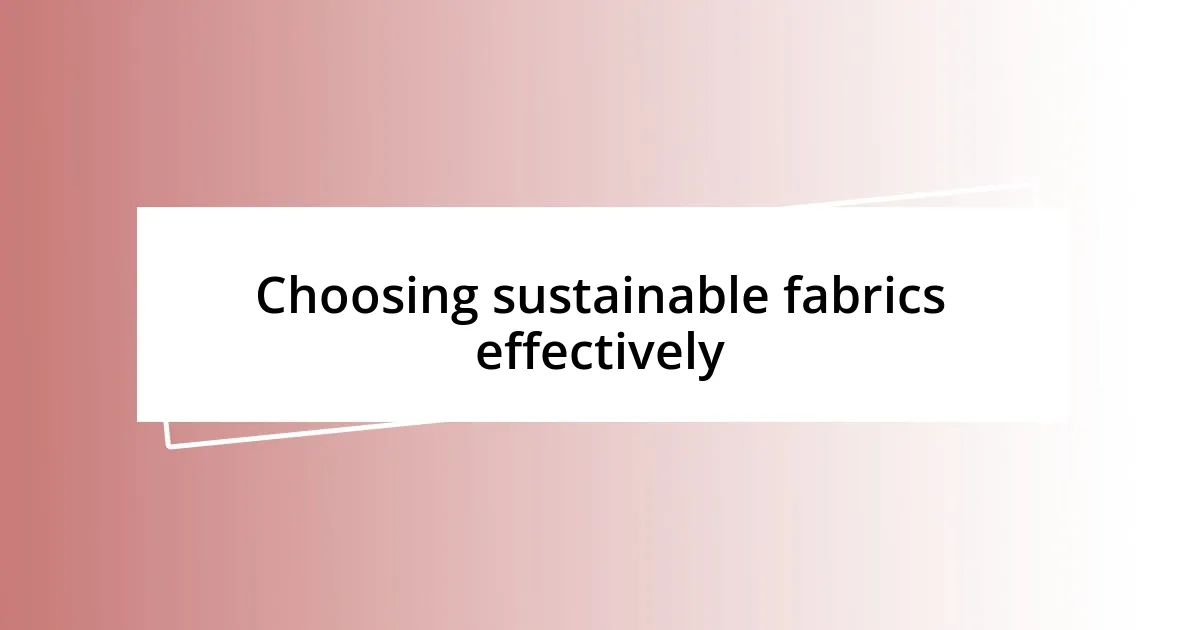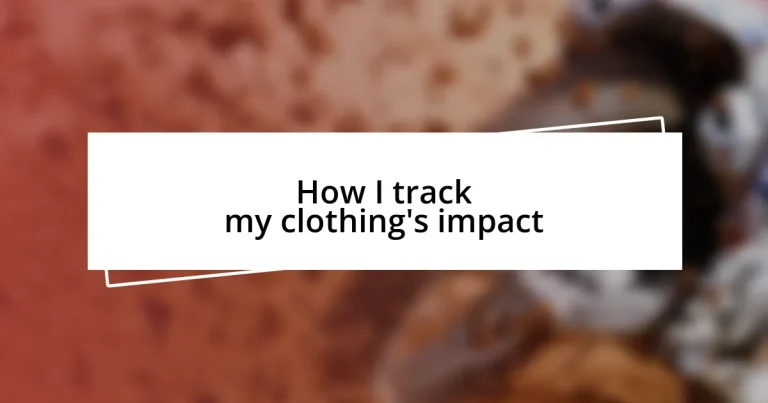Key takeaways:
- The fashion industry contributes approximately 10% of global carbon emissions, prompting a reevaluation of personal shopping habits and their environmental impact.
- Choosing sustainable fabrics, such as organic cotton and recycled polyester, can significantly reduce environmental harm and align clothing choices with eco-friendly values.
- Tracking the lifecycle of garments fosters informed consumer decisions, highlighting the importance of transparency in the supply chain.
- Sharing impact tracking results with others cultivates a supportive community focused on sustainability and encourages collective accountability for wardrobe choices.

Understanding clothing’s environmental impact
When I dive into the environmental impact of clothing, I often reflect on my own shopping habits. I remember a time I was drawn to an ultra-fast fashion sale, lured by low prices and trendy styles. However, I later learned that such shopping sprees contribute significantly to pollution and waste, making me question: how much is the thrill of a new outfit worth if it harms the planet?
The statistics can be staggering; did you know that the fashion industry is responsible for about 10% of annual global carbon emissions? It really hit me when I realized that my favorite cotton shirt comes at a cost much larger than the price tag. Understanding that cotton production requires vast amounts of water and pesticides made me rethink my wardrobe choices. It was a wake-up call to consider not just what I wear, but the ripple effects of those choices.
As I tracked my clothing’s journey, I discovered that synthetic fibers release microplastics during washing, adding another layer of complexity to the impact. This revelation left me wondering about the clothes I put on daily: Are they supporting sustainability or contributing to ongoing environmental issues? By pondering these questions, I feel a deeper connection to my wardrobe and the responsibility I have in making wiser, eco-friendly choices.

Choosing sustainable fabrics effectively
Choosing sustainable fabrics can feel overwhelming, but I’ve learned that a few key considerations can make the process easier and more impactful. When I shop, I now prioritize materials that are both eco-friendly and ethically sourced. For instance, opting for organic cotton or Tencel not only aligns with my values but also reduces the environmental burden.
Here’s a quick list to consider when selecting sustainable fabrics:
– Organic Cotton: Grown without harmful pesticides and fertilizers, it’s a healthier choice for both the environment and farmers.
– Hemp: A hardy plant that requires less water and can grow in poor soil, making it an excellent alternative.
– Recycled Polyester: Made from recycled plastic bottles, it helps to divert waste from landfills and uses fewer resources than virgin polyester.
– Tencel (Lyocell): Produced from sustainably sourced wood, its production process uses closed-loop technology to minimize waste.
– Bamboo: A rapidly renewable resource that requires minimal water, but be sure to check for eco-friendly processing methods.
Reflecting on my journey, I remember discovering a small, local brand that used hemp for their clothing. Not only did their products feel soft and breathable, but I felt an emotional connection to the company’s mission to promote sustainability. That experience solidified my resolve to make thoughtful choices every time I shop. Each time I wear these sustainable fabrics, I feel a sense of pride, knowing I am contributing to a healthier planet.

Tracking garment lifecycle transparently
Tracking the lifecycle of a garment has become a personal priority for me. I remember my first encounter with a brand that offered detailed transparency about their supply chain. Each garment came with a tag that traced its journey from farm to factory, revealing everything I needed to know about production practices and environmental impacts. It was like peeling back layers of an onion, and with each layer, I felt increasingly empowered to make informed choices.
The process of tracking a garment’s lifecycle can be simplified by understanding the key stages: raw material sourcing, manufacturing, distribution, usage, and end-of-life options. When I examine any new piece of clothing, I consider questions like: Where did the cotton come from? How were my jeans made? What happens to them when I’m done wearing them? Reflecting on these stages not only provides clarity but also cultivates a deeper appreciation for the clothing I choose.
To further illustrate the differences in garment tracking practices, I’ve created a simple comparison of two brands: one focusing on transparency and sustainability, and another with limited information. This table highlights how varied approaches impact my shopping decisions.
| Feature | Brand A (Transparent) | Brand B (Limited Info) |
|---|---|---|
| Material Sourcing | 100% organic cotton, sourced locally | Conventional cotton, unknown origin |
| Sustainability Certifications | GOTS, Fair Trade | None listed |
| Manufacturing Information | Factories in ethical locations, worker details provided | General manufacturing location |
| End-of-Life Options | Recycling program available | No recycling info provided |
In my experience, actively tracking these details not only empowers me as a consumer but also fosters a sense of community and shared responsibility in making sustainable choices. It’s a journey I’m proud to embark on every day, one outfit at a time.

Measuring carbon footprint of clothing
Measuring the carbon footprint of clothing involves understanding the total greenhouse gas emissions from its production, distribution, and use. I’ve come to realize just how complex this measurement can be. For instance, thinking about the emissions generated just to grow cotton or produce synthetic fibers was eye-opening for me. By simply checking eco-labels or carbon footprint calculators, I can get a clearer sense of how my wardrobe choices affect the environment.
One experience that deeply impacted me was when I attended a workshop on sustainable fashion. The facilitator explained how the carbon footprint of a single t-shirt can range from 2.5 to over 10 kg of CO2 depending on various factors like the production method and transportation. It struck me then that my everyday choices accumulate into something much larger. Since that day, I’ve taken the time to research brands that transparently share their carbon footprints and commit to reducing them.
I often find myself asking, “What if everyone prioritized understanding their clothing’s impact?” That thought motivates me to keep learning. For example, I’ve started recording the carbon footprints of new purchases, and I’ve noticed how this awareness can transform my shopping habits. Now, when I consider buying something, I ask, “Is this worth its weight in carbon emissions?” This mindset helps me make choices that feel right for both myself and the planet.

Utilizing clothing impact calculators
Utilizing clothing impact calculators has been a game-changer for me in understanding the environmental consequences of my wardrobe. There are various online tools available that enable me to input details about my clothing, such as the materials used and the manufacturing process. Just the other day, I used one for my favorite hoodie. The calculator revealed it contributed significantly to my carbon footprint. That moment made me rethink my attachment to fast fashion items.
What I particularly enjoy about these calculators is how they break down impact into digestible bits of information. I can see where my clothing ranks in terms of sustainability and the resources it consumes. For example, I once discovered that a seemingly innocuous item, like a pair of synthetic running shoes, used a staggering amount of water in its production. It’s fascinating—and a little unsettling—how these numbers can shift my perspective on what I choose to wear.
I often ponder, “How much do I really know about the clothing I buy?” By using impact calculators, I feel more in control of my choices. They empower me to make decisions that align with my values of sustainability. The more I engage with this tool, the more I realize that it’s not just about reducing my carbon footprint; it’s about initiating a bigger conversation around sustainable fashion. Every time I share these insights with friends, I sense that we’re all on this journey together, slowly piecing together the impact of our clothing choices in a meaningful way.

Building a personal wardrobe audit
Building a personal wardrobe audit starts with honesty and observation. I remember going through my closet on a particularly rainy day, pulling out pieces that I hadn’t worn in ages. As I examined each item, I asked myself, “Does this truly represent me and my values?” This simple reflection helped me realize how much of my wardrobe was filled with impulsive purchases rather than pieces that I genuinely cherished.
Next, I dove deeper by creating a spreadsheet listing each item alongside its carbon footprint and production details. This was surprisingly enlightening. For instance, I discovered some garments were made from environmentally harmful materials that I had once adored but had no idea about their impact. It made me question not just what I owned, but why I ever decided to buy them. I found it liberating to separate the essentials from the emotional attachments, allowing me to curate a wardrobe that feels both authentic and responsible.
Finally, I recommend setting aside time periodically for this audit—maybe every season. I now look forward to this ritual, almost like a wardrobe cleanse, where I reevaluate what I wear. Whenever I find myself saying, “I’ll wear this someday,” I recognize it’s a sign that I need to let it go. How can we truly embrace sustainable fashion if we’re holding onto items that no longer serve us? With each audit, I feel lighter and closer to a wardrobe that speaks to my values and the planet’s needs.

Sharing impact tracking results
Sharing the results of my impact tracking has become a meaningful part of my personal journey toward sustainability. Recently, I decided to host a small gathering with friends where I displayed my findings. I showed them specific carbon footprint numbers and water usage stats from my favorite pieces. It’s amazing how just a simple conversation can ignite curiosity and inspire shared commitments to make more mindful choices in our wardrobes.
I remember vividly when one friend looked at her own clothing and realized the impact of her fast fashion purchases. She shared her own experiences and soon our conversations evolved into discussions about alternatives. By openly discussing our findings, we not only educated each other but also formed a supportive community. It’s like we’re in our own little support group, each person contributing insights and inspirations, making the journey a shared experience with collective accountability.
Sometimes, I think, “How much more could we learn if we opened up these conversations beyond our circle?” When I share my impact tracking results, I aim to encourage others to think critically about their choices, too. This dialogue isn’t just about the numbers; it’s about connecting emotionally with our clothing and recognizing the stories they carry. By sharing my findings, I find a deeper sense of purpose in both my choices and my relationships, turning a solitary endeavor into a collaborative mission for change.














